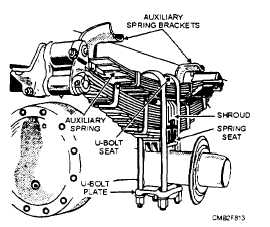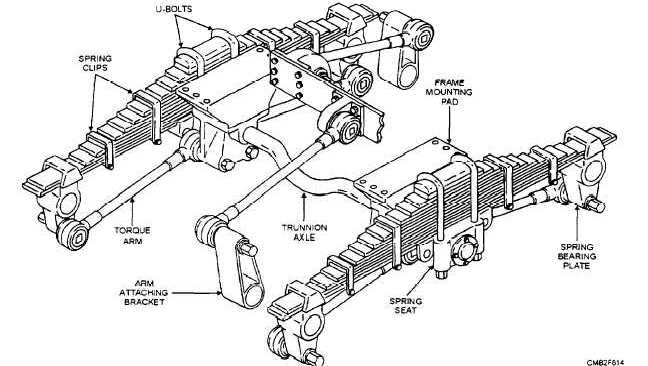
Figure 8-13. - Auxiliary spring.
from the main spring. In either case, the ends of the spring has it own support brackets. When the truck is under a load, the auxiliary spring assumes part of the load when its ends contact the bearing plates or special brackets attached to the frame side rails.
A large portion of six-wheel drive vehicles utilize a bogie suspension (fig. 8-14) which uses leaf springs. This suspension is a unit consisting of two axles joined by torque rods. A trunnion axle acts as a pivot for the drive axles and is supported by bearings that are part of the spring seat. The ends of each spring rest in the guide brackets bolted to the axle housings. Mounting the springs on central pivots enable them to distribute half of the rear load onto each axle. As a result, this type of suspension allows the vehicle to carry a much heavier load than a single axle without losing its ability to move over unimproved terrain.
When one wheel of a bogie suspension is moved up or down because of an irregularity in the road, the spring pivots on the trunnion shaft and both ends of the spring deflect to absorb the road shock. This causes the load to be placed on the center of the spring resulting in equal distribution of the load to both axles. The torque rods ensure proper spacing and alignment of the axles and transmit the driving and braking forces to the frame.
Torsion Bar
The torsion bar consists of a steel rod made of spring steel and treated with heat or pressure to make it elastic, so it will retain its original shape after being twisted. Torsion bars, like coil springs, are frictionless and require the use of shock absorbers. The torsion bar is serrated on each end and attached to the torsion bar anchor at one end and the suspension system at the other end (fig. 8-15). Torsion bars are marked to indicate proper installation by an arrow stamped into the metal. It is essential that they be installed properly because they are designed to take the stress in one direction only. The up-and-down movement of the suspension system twists the steel bar. The torque resistance will return the suspension to its normal position in the same manner as a spring arrangement.

Figure 8-14. - Bogie suspension.
Continue Reading